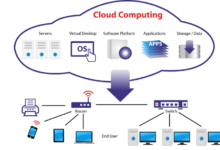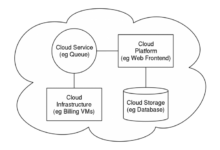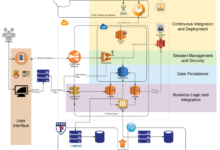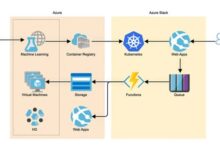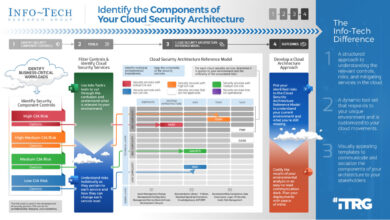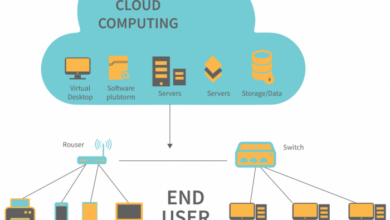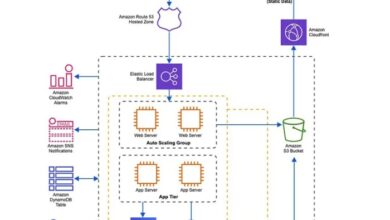How Cloud Architecture Diagrams Pave the Way for Scalability in Cloud Computing
In the ever-evolving realm of cloud computing, scalability stands as a cornerstone for businesses seeking to adapt and thrive in a dynamic digital landscape. Cloud architecture diagrams emerge as indispensable tools in this pursuit, providing a visual roadmap for designing and implementing scalable cloud solutions.
These diagrams serve as blueprints, enabling architects and engineers to visualize the intricate components of a cloud architecture, identify potential bottlenecks, and optimize resource allocation. Join us as we delve into the world of cloud architecture diagrams, uncovering their significance in achieving scalability and exploring the practical considerations and tools that empower their creation.
Overview of Cloud Architecture Diagrams
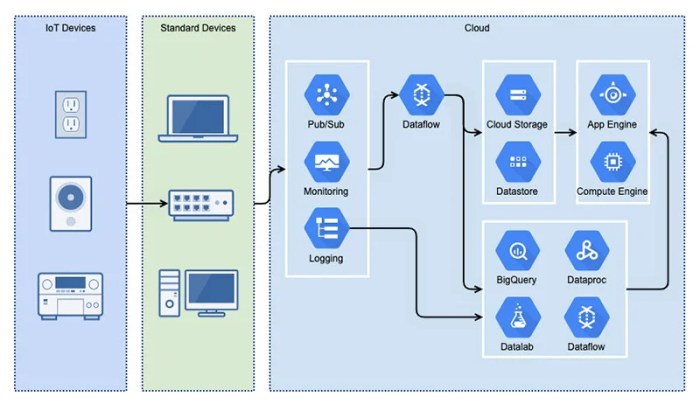
Cloud architecture diagrams visually represent the components, relationships, and interactions within a cloud computing environment. These diagrams are essential for planning, designing, and managing cloud-based systems and applications. They provide a comprehensive view of the cloud architecture, helping stakeholders understand how different components work together to achieve scalability, reliability, and security.
Types of Cloud Architecture Diagrams
There are several types of cloud architecture diagrams, each serving a specific purpose:
- Logical Architecture Diagrams: Depict the high-level components and their relationships within a cloud system, focusing on the logical structure rather than physical implementation.
- Physical Architecture Diagrams: Illustrate the physical infrastructure and network components used to support the cloud environment, including servers, storage, and network devices.
- Deployment Architecture Diagrams: Show how cloud resources are deployed across different cloud environments, such as public, private, or hybrid clouds.
- Data Flow Diagrams: Represent the flow of data between different components in a cloud system, helping identify potential bottlenecks and optimize data transfer.
- Security Architecture Diagrams: Illustrate the security controls and measures implemented within a cloud environment to protect data and resources from unauthorized access.
Benefits of Cloud Architecture Diagrams for Scalability
Cloud architecture diagrams play a crucial role in achieving scalability in cloud computing:
- Visualizing Scalability: Diagrams help visualize how different components can be scaled up or down to meet changing demands, ensuring optimal resource utilization and cost-effectiveness.
- Identifying Scalability Issues: By analyzing the architecture diagrams, stakeholders can identify potential bottlenecks and scalability limitations, enabling proactive measures to address them.
- Planning for Scalability: Diagrams facilitate planning for future scalability requirements, ensuring that the cloud architecture is designed to accommodate growth and changing needs.
- Communicating Scalability: Diagrams provide a common language for stakeholders to communicate about scalability, ensuring that everyone has a clear understanding of the system’s capabilities and limitations.
Scalability in Cloud Computing
Scalability in cloud computing refers to the ability of cloud-based systems to adapt to changing demands or workloads. It involves the capability of a cloud architecture to seamlessly handle variations in resource requirements without compromising performance or availability. Scalability ensures that applications can expand or contract resources as needed, optimizing resource utilization and cost-effectiveness.
Types of Scalability
There are two primary types of scalability in cloud computing:
- Horizontal Scalability: Also known as scale-out, this involves adding or removing computing resources, such as virtual machines or containers, to adjust to changing demands. It allows applications to distribute workloads across multiple servers, enabling them to handle increased traffic or data processing requirements.
- Vertical Scalability: Also known as scale-up, this involves increasing or decreasing the capacity of existing resources, such as CPU, memory, or storage, within a single server or virtual machine. It is suitable for applications that experience sudden spikes in demand or require specialized hardware configurations.
Scalable Cloud Services and Applications
Numerous cloud services and applications leverage scalability to meet varying demands:
- Web Applications: Cloud-based web applications can scale horizontally by adding more servers to handle increased traffic during peak hours and scale down during low-traffic periods.
- Big Data Analytics: Cloud platforms offer scalable data processing and storage solutions for big data analytics. They can scale horizontally to distribute large datasets across multiple servers and scale vertically to increase the processing power of individual servers.
- Machine Learning: Cloud-based machine learning platforms can scale horizontally to train and deploy models on multiple servers, reducing training time and improving accuracy.
- Video Streaming: Cloud-based video streaming services can scale horizontally to handle fluctuations in the number of concurrent viewers and vertically to improve the quality of the streamed content.
- Gaming: Cloud gaming platforms can scale horizontally to accommodate more players and vertically to provide high-quality gaming experiences.
Role of Cloud Architecture Diagrams in Scalability
Cloud architecture diagrams serve as valuable tools in visualizing and planning for scalability within cloud computing environments.
These diagrams enable IT professionals to gain a comprehensive understanding of the system’s components, their interconnections, and how they contribute to scalability. By analyzing these diagrams, stakeholders can identify potential bottlenecks, optimize resource allocation, and plan for future capacity needs.
Visualizing and Planning for Scalability
Cloud architecture diagrams provide a visual representation of the system’s architecture, allowing stakeholders to grasp the overall structure and identify areas that may impact scalability. This visualization helps in understanding how different components interact and how they can be scaled independently or together to meet changing demands.
Identifying Potential Bottlenecks
Cloud architecture diagrams aid in identifying potential bottlenecks that may hinder scalability. By analyzing the relationships between components, IT professionals can pinpoint areas where performance may be constrained due to limited resources or inefficient design. This enables them to address these bottlenecks proactively and implement solutions to improve scalability.
Optimizing Resource Allocation
Cloud architecture diagrams facilitate the optimization of resource allocation within the cloud environment. By understanding the resource requirements of each component and their interdependencies, stakeholders can make informed decisions on resource allocation. This optimization helps ensure that resources are utilized efficiently, reducing costs and improving overall performance.
Capacity Planning and Forecasting Future Demands
Cloud architecture diagrams play a crucial role in capacity planning and forecasting future demands. By analyzing historical data and trends, IT professionals can estimate future capacity needs and plan accordingly. This proactive approach helps organizations avoid performance issues and ensure that the cloud environment can accommodate future growth and evolving requirements.
Design Considerations for Scalable Cloud Architectures
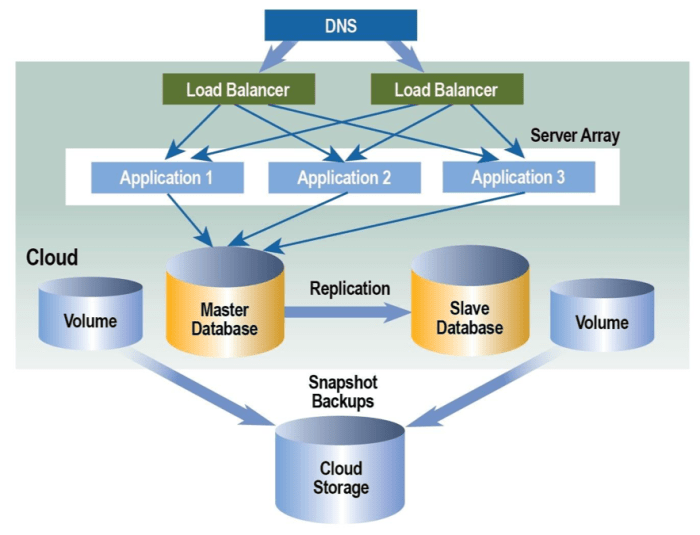
Building scalable cloud architectures requires careful planning and consideration of several key factors. These considerations ensure that the architecture can adapt to changing demands, handle increased traffic, and maintain performance and reliability.
Modularity
Modularity is a fundamental design principle for scalable cloud architectures. It involves decomposing the architecture into independent, self-contained modules or components. This modular approach allows for easy addition, removal, or modification of modules without affecting the entire system. It also facilitates the distribution of workload across multiple modules, improving scalability and performance.
Loose Coupling
Loose coupling is another essential design consideration for scalability. It refers to minimizing the dependencies between different components of the architecture. By reducing interdependencies, loose coupling allows for greater flexibility and agility in scaling the architecture. It also helps isolate failures and prevent cascading effects, enhancing the overall reliability and resilience of the system.
Fault Tolerance
Fault tolerance is crucial for ensuring the scalability and reliability of cloud architectures. It involves designing the architecture to withstand and recover from failures, whether hardware, software, or network-related. Fault tolerance techniques include redundancy, load balancing, failover mechanisms, and self-healing capabilities.
By incorporating fault tolerance, cloud architectures can maintain high availability and performance even in the face of failures.
Design Patterns and Best Practices
Several design patterns and best practices have emerged for building scalable cloud architectures. These include:
- Microservices Architecture: Breaking down the application into small, independent services that communicate through lightweight protocols.
- Containerization: Packaging applications and their dependencies into lightweight, portable containers that can be easily deployed and managed.
- Load Balancing: Distributing traffic across multiple servers or instances to improve performance and scalability.
- Caching: Storing frequently accessed data in a temporary storage layer to reduce the load on the main data store and improve performance.
- Content Delivery Networks (CDNs): Distributing static content, such as images and videos, across geographically distributed servers to reduce latency and improve user experience.
Tools and Techniques for Creating Cloud Architecture Diagrams
Creating cloud architecture diagrams requires the use of appropriate tools and techniques. These tools offer features and capabilities that aid in designing, visualizing, and communicating cloud architectures effectively.
Selecting the Right Tool
Choosing the right tool for creating cloud architecture diagrams depends on several factors, including the complexity of the architecture, the level of detail required, and the desired output format. Some key considerations include:
- Ease of Use: The tool should have a user-friendly interface and a low learning curve, allowing users to create diagrams quickly and easily.
- Feature Set: The tool should offer a comprehensive set of features, including shape libraries, connectors, and layout options, to support the creation of detailed and informative diagrams.
- Integration and Compatibility: The tool should integrate with other tools and platforms used in the cloud architecture design process, such as cloud management platforms and infrastructure-as-code tools.
- Output Formats: The tool should support various output formats, such as images, PDFs, and SVGs, to cater to different presentation and documentation needs.
Common Tools and Techniques
There are numerous tools and techniques available for creating cloud architecture diagrams. Some popular options include:
- Diagramming Software: Specialized diagramming software, such as Lucidchart, Draw.io, and Visio, provides a comprehensive set of features and templates specifically designed for creating cloud architecture diagrams.
- Cloud-Based Platforms: Cloud-based platforms, such as AWS Architecture Center and Azure Architecture Center, offer built-in tools and templates for creating cloud architecture diagrams, often tailored to specific cloud platforms.
- Infrastructure-as-Code (IaC) Tools: IaC tools, such as Terraform and CloudFormation, allow users to define cloud infrastructure in code, which can then be visualized as a cloud architecture diagram.
- Whiteboarding and Sketching: Traditional whiteboarding and sketching can be used to create quick and rough cloud architecture diagrams for brainstorming and initial design discussions.
Strengths and Weaknesses of Different Tools
Each tool or technique has its own strengths and weaknesses. Diagramming software offers a wide range of features and customization options but may have a steeper learning curve. Cloud-based platforms are easy to use and provide pre-built templates, but they may be limited in terms of flexibility and customization.
IaC tools provide a structured approach to cloud architecture design but require technical expertise in coding. Whiteboarding and sketching are quick and easy but may lack the precision and detail of digital tools.Choosing the appropriate tool depends on the specific needs and preferences of the cloud architect or team.
A combination of tools and techniques may also be used to create comprehensive and effective cloud architecture diagrams.
Case Studies and Examples
Cloud architecture diagrams have been instrumental in achieving scalability in numerous real-world scenarios. Let’s explore some case studies that showcase the challenges faced, solutions implemented, and the comparative analysis of cloud architecture diagrams used.
Netflix: Scaling for Streaming Services
Challenges: Netflix faced significant challenges in scaling its streaming services to meet the demands of a rapidly growing user base. Solutions: Netflix employed a microservices architecture, leveraging cloud architecture diagrams to design and implement a highly scalable and resilient infrastructure.
This involved breaking down the monolithic application into smaller, independent services, each responsible for a specific task. Comparative Analysis: Netflix utilized various cloud architecture diagrams, including logical architecture diagrams, deployment diagrams, and network diagrams, to visualize and communicate the complex interactions between its microservices.
These diagrams facilitated effective collaboration among development teams and streamlined the troubleshooting process.
Amazon Web Services (AWS): Cloud Infrastructure Scalability
Challenges: AWS needed to design a cloud infrastructure that could handle the varying demands of its customers, from small businesses to large enterprises. Solutions: AWS developed a multi-tenant architecture, employing cloud architecture diagrams to map out the shared resources and isolated customer environments.
This approach enabled efficient resource utilization and ensured scalability without compromising security. Comparative Analysis: AWS used a combination of physical architecture diagrams, logical architecture diagrams, and data flow diagrams to illustrate the interconnections between its data centers, regions, and availability zones.
These diagrams provided a comprehensive view of the AWS infrastructure and aided in capacity planning and performance optimization.
Google Cloud Platform (GCP): Scaling for Data Analytics
Challenges: GCP aimed to build a scalable platform for data analytics that could handle massive datasets and complex computations. Solutions: GCP implemented a distributed computing architecture, utilizing cloud architecture diagrams to design and deploy a network of interconnected nodes.
This architecture enabled parallel processing of data, significantly reducing computation time and improving scalability. Comparative Analysis: GCP employed a range of cloud architecture diagrams, including component diagrams, sequence diagrams, and use case diagrams, to capture the interactions between its various components, services, and users.
These diagrams facilitated effective communication among stakeholders and ensured a cohesive understanding of the platform’s architecture.
Final Thoughts
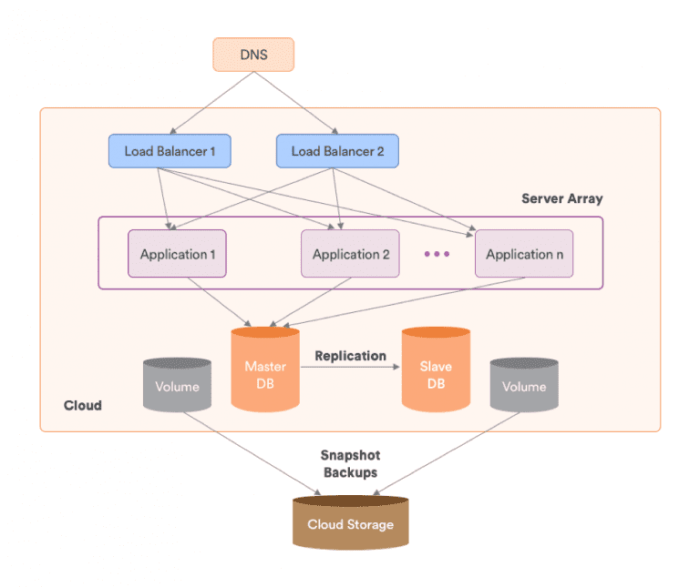
In conclusion, cloud architecture diagrams stand as invaluable assets in the quest for scalability in cloud computing. They provide a structured framework for visualizing, planning, and optimizing cloud architectures, ensuring that they can seamlessly adapt to changing demands and maintain peak performance.
As cloud technologies continue to revolutionize industries, these diagrams will undoubtedly remain indispensable tools for architects and engineers seeking to harness the full potential of the cloud.
